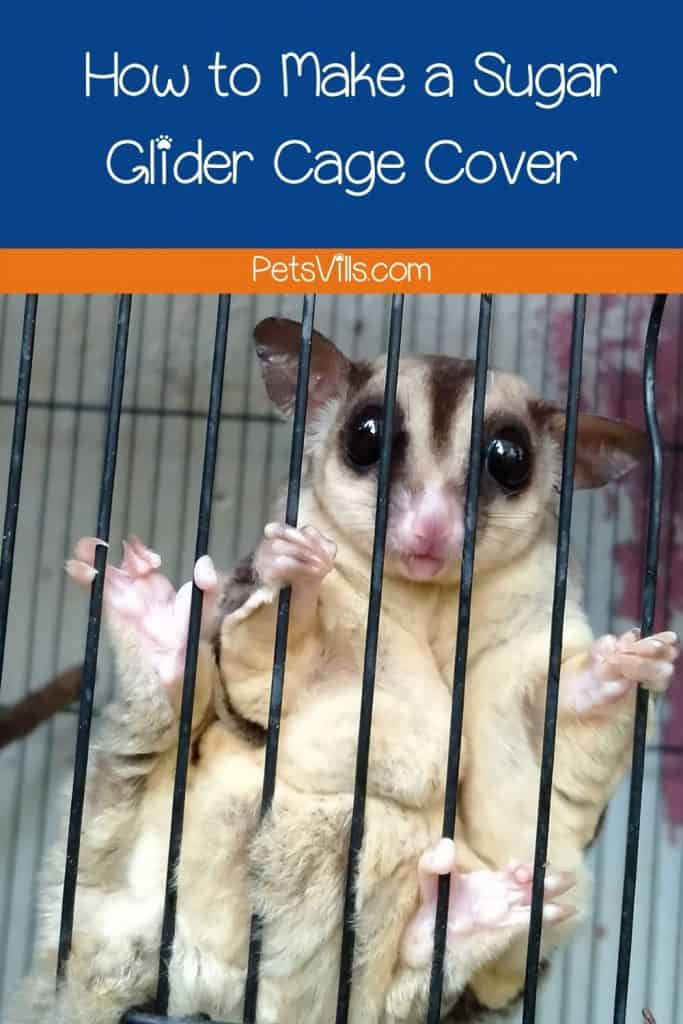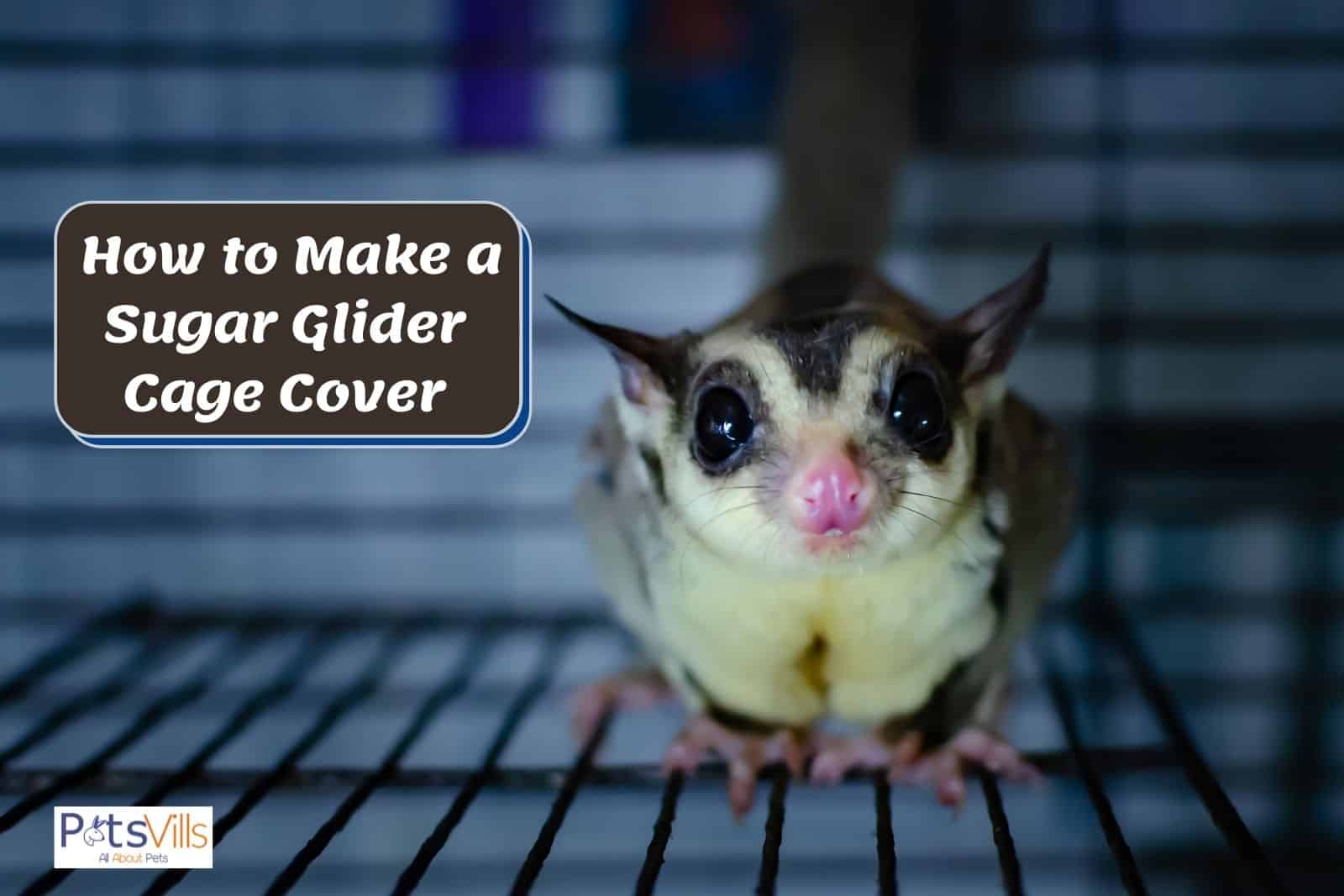Want to learn how to make a sugar glider cage cover?
I’ve put together a step-by-step guide for two different styles of glider cages so you can make the perfect DIY cage for your pet.
Making your cover is easy to do and saves you money. I’ve included a sew and no-sew tutorial to make it simple for ANYONE to create a beautiful and functional cage.
Check: Best Cages for Sugar Gliders
Table of Contents
Making a Sugar Glider Cage Cover: 2 Tutorials
My daughter wanted a cage cover because our cat kept disturbing her pet gliders.
Aside from disturbances, gliders also need peace [1] when they rest, so a cage cover is imperative.
To create a safe and secure space for your glider, follow my step by step tutorial below to find out how you can make your custom cage covers:
ALSO READ: How to Set Up a Sugar Glider Cage
TUTORIAL 1: How to Make A No-sew Sugar Glider Cage Covers
This type of cage covers only three sides, including the cage’s back – but not the top part of the cage doors.
Things You Will Need to Make a No-Sew Sugar Glider Cage Cover:
- One large blanket measuring at least 60 x 70 inches (This measurement is for a full-size MidWest Double Critter Nation cage.
- If you have a smaller enclosure, use half the blanket or buy smaller pieces of
- fleece).
- You can cover your cage in a fleece material to avoid clutter
- 8-10 clothespins
6 Steps for Making a No-Sew Sugar Glider Cage Cover
- Open the blanket.
- Place one corner of the blanket on the left side of the cage and cover the entire left side.
- Fix this side of the blanket to one of the bars on the top of the cage’s left side using a clothespin. Then, fix a few more clothespins and secure the blanket thoroughly on the entire left side.
- Wrap the blanket around the cage’s back and attach a few more clothespins to secure the blanket to the back of the cage.
- Bring the blanket round to the right side of the cage and affix it to the right side with the clothespins.
- If you also want to cover the front and top, you can use another blanket. Secure the blanket to the top and front.
If needed, cut a small hole in the front part so you can check on your gliders from time to time.
This video shows you the above procedure.
TUTORIAL 2: How to Make a Sewn Sugar Glider Cage Cover?
Things You’ll Need to Make a Sewn Glider Cover
- Measuring tape
- Scissors
- Needle and thread or sewing machine
- Adequate fleece cloth/plastic sheet (explained below). For a large cage, you’d need at least 6 yards of fleece/sheet.
You can use the extra fleece to make other items like a fleece pouch for your glider. Check how to sew it here:
4 Steps for Making a Sewn Sugar Glider Cage Cover
- For a sewn cage cover measure the top, height, and sides of the cage.
- Add enough extra for seams, hems, and overlaps at the corners.
- I used ¼ inch allowance for each side. 1 inch hem, and ¼ inch extra on each side.
- For example, if the top part of your cage measures 36 x 30 inches, then the top piece of your fleece should measure 37 x 31 inches.
If the front part of your cage measures 36 inches wide and 24 inches high, then the front piece to cut would be 37.5″ x 25.25″.
Similarly, if the side is 30 wide and 24 high, the cut piece would be 31 x 25.25 inches. So you’d need two of these for the two sides of the cage.
- Once you have cut your fleece, sew straight stitches on the side hems by turning under ¼ inch on the vertical sides.
- Turn under 1-inch on the bottom hems and stitch the bottom hem panels on all four sides.
- Always start with the top first. You can use pins to hold the sides in place before you stitch. Make sure you pin the right side of each panel.
- Do the back side last. Remove the pins as you complete sewing each side.
- Leave the front piece unsewed to the left and right side panels so you can roll it up during the daytime.
- Once the cover is done, place it on the cage.
Here is a video tutorial that shows you how to execute the process above.
Even though making a cover is simple enough, you can still also buy one if it’s more convenient.
Buy a Sugar Glider Cage Cover To Save Time
If the above processes seem complex, you can always buy your pet a cover to attach to the cage bar.
I recommend the Exotic Nutrition Madagascar Cage Cover as it is available in different sizes, is machine-washable, and allows room for other cage accessories.
You can also roll up its front part during the day time or whenever you want to check on your pets.
Also Check: Homemade Sugar Glider Cage
5 Benefits of Using a Sugar Glider Cage Cover
The experts from Aurora Animal Hospital [2] recommend the following benefits of using covers for gliders:
#1. Covers Prevent Drafts in the Cage
Many people use a heat lamp to warm their gliders if their house gets very chilly in the winters.
But these can make the cage very stuffy and can overheat your gliders.
If you live in a relatively warm climate, covers are the only thing you’d need to prevent cool drafts from getting into the cage.
In summers, the cover can also prevent drafts from the air conditioner.
Here is a video showing how to keep gliders warm in winters.
#2. Cage Covers Prevent Mess on Your Walls
I have the gliders’ cage backed up against the wall at my place.
Before I started using the covers, food and urine would splash on the walls. Cage covers contain the mess.
You can also add a glider kitchen which helps with keeping their cage cleaner. Use Easy-to-clean, waterproof material such as fleece.
#3. Covers Reduce Aggression
If you have other pets like cats, dogs, or even other small animals in two adjacent cages, then a cover can prevent aggression between them and help temperament in gliders.
Here are some vet recommended tips [3] to keep your gliders safe from other house pets.
#4. Prevents Cross-Contamination
If you have two cages side-by-side, cage covers can prevent food fights between the occupants. It can also prevent contamination between the two cages should there be a disease outbreak.
#5. Works as a Fashion Statement
Cages – especially the wire ones – sometimes look rather harsh. A cover can make the cage look prettier and neater and even enhance your room’s decor.
You can even match your cover to your cage set for a stylish look
Sugar Glider Cover FAQs
Do sugar gliders need to be covered at night?
Sugar gliders are nocturnal creatures [4]. Therefore, covering sugar glider cages at night time is not mandatory.
Still, it can give them the privacy they need to explore their cage, play with each other, or communicate without prying eyes.
What materials are best for sugar glider cage covers?
Anti-pill fleece cage cover, denim, and other tightly-woven fabrics are suitable for gliders. This way, their nails won’t get stuck in the cloth.
Conclusion
A glider cage can keep your gliders more comfortable and make them feel safe.
It can also prevent drafts and food messes.
It is easy to make a DIY sugar glider cage cover – and you can choose from the sew and no-sew options. I hope the above step-by-step tutorials help you.
References
- 1. petMD. Guide to Sugar Gliders as Pets | petMD [Internet]. Petmd.com. 2017. Available from: https://www.petmd.com/exotic/care/all-about-sugar-gliders
- 2. Willems D. Sugar Glider Care [Internet]. Available from: https://static1.squarespace.com/static/5706bdd507eaa0b8239942b7/t/608758a4d1d63b653fa9aa86/1619482788449/SugarGliderCaresheetAuroraAnimalHospital.pdf
- 3. Special Considerations for Sugar Gliders – All Other Pets [Internet]. MSD Veterinary Manual. [cited 2021 Dec 20]. Available from: https://www.msdvetmanual.com/all-other-pets/sugar-gliders/special-considerations-for-sugar-gliders
- 4. Sugar Glider Facts [Internet]. Animals. 2018 [cited 2021 Dec 20]. Available from: https://www.nationalgeographic.com/animals/mammals/facts/sugar-glider#:~:text=Often%20compared%20with%20flying%20squirrels

Have you tried making a sugar glider cage cover? Let us know in the comments below!
Alina Hartley is a small-town girl with a ginormous love of bearded dragons. It all started with Winchester, a baby bearded who was abandoned at the shelter by his former owners because of a birth defect that caused one front leg to be shorter than the other. Alina originally went to the shelter looking for a guinea pig, but one look at Winchester and it was love at first sight. From that day on, Alina has dedicated her life to learning everything she can about bearded dragons. She loves helping new beardie parents start their incredible journey with these magnificent reptiles.
Follow her on:
LINKEDIN
TWITTER.
Read her latest articles HERE
Learn more about her HERE.




![Cute Sugar Glider Drinking From The Bottle [Must-Watch Video]](https://petsvills.com/wp-content/uploads/2022/09/Cute-Sugar-Glider-Drinking-From-The-Bottle-Must-Watch-Video-211x150.jpg)
